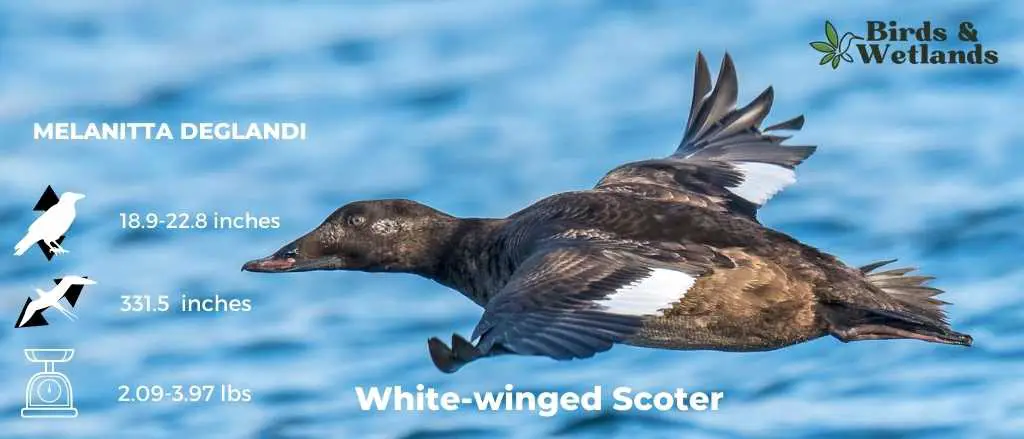The white-winged scoter (Melanitta fusca) is a large sea duck member of the genus Melanitta, which includes the surf scoter and other scoters. It is the largest of the North American scoter species.
It is a migratory bird native to North America and can be found in coastal environments and open waters.
The white-winged scoter is unique among scoters for its white wing patches, which are prominent in flight and give the bird its name.
Scientific Name: Melanitta deglandi
Length: 18.9-22.8 in (48-58 cm)
Wingspan: 31.5 in (80 cm).
Average Weight: 33.5-63.5 oz (950-1800 g)
Physical Description
Adult male white-winged scoters have a distinctive black head and bill, a sloping forehead, glossy black bodies with a large white patch on the black wing. They have a white half-crescent patch around their pale gray eyes.
Their short orange bills have a red nail or tip and a large know at the base. They have reddish-pink legs and webbed feet with black webbing.
Adult female white-winged scoters have a brown head and sloping dark bill with a less prominent dark knob at the base and a mostly dark brown body with a large white patch on the wings. They have brown eyes.
Perhaps, the most noticeable characteristic of the female is the two white patches on the face — one near the base of the bill and another adjacent to the ear coverts.
Juvenile white-winged scoters are similar in appearance to adult females but with a more mottled and streaked plumage.
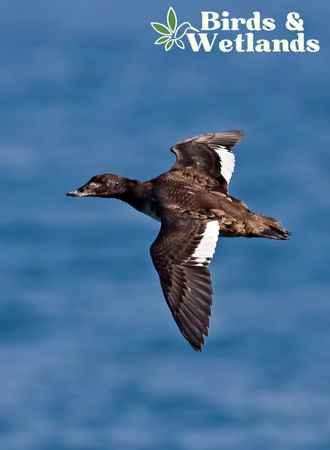
Listen to White-Winged Scoter
Habitat & Breeding Range
The white-winged scoter is a waterfowl that is native to North America.
These large sea ducks breed in the Northwest Territories and northwestern Canada and Alaska in summer, especially east of Hudson Bay. Their breeding grounds are near wetlands and shallow lakes in boreal and subarctic forests.
In the winter, the white-winged scoters migrate to coastal waters along the Pacific and Atlantic coasts and in Puget Sound. Large flocks favor shallow water, inlets, bays, islands, large freshwater lakes, shellfish beds and estuaries where they rest and feed. They are rare in the ocean and open country during spring.
Meanwhile, large populations can be found along the eastern coast from the Gulf of St Lawrence to northern Florida. Some birds may also migrate south in search of warmer climates and food.
Some white-winged scoters spend winters along the Gulf Coast and inland on large lakes and rivers throughout much of the southern USA.
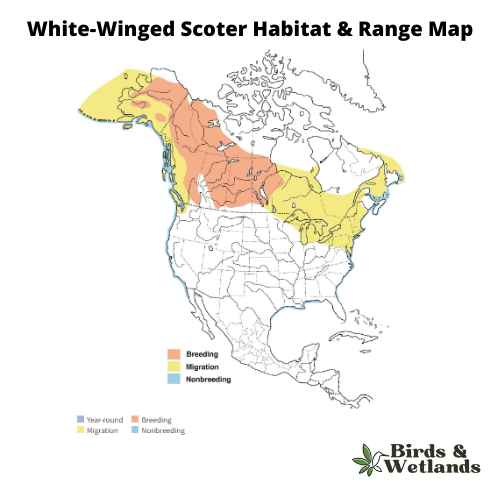
Food Habits & Diet
White-winged scoters are omnivorous birds with a varied diet, consisting mostly of aquatic invertebrates, crustaceans, mollusks, small fish, and aquatic insects. They occasionally eat plants to supplement their diet.
These ducks have adapted to live in various habitats and use different techniques to find food, such as diving and dabbling. They rely on coastal habitats during migration and are important for maintaining balance in these ecosystems.

Nesting & Mating Habits
White-winged scoters are monogamous and typically form pairs in late winter or spring before they migrate to their breeding grounds.
During courtship, several males will display for a single female. These courtship displays involve lowering the head and arching the back before rushing over short distances on the water’s surface. Several males on short underwater chases often pursue one female.
Before copulation, the paired birds engage in preening and false drinking.
The breeding season starts in early May to late summer.
The white-winged scoter nests in isolated nesting spots near the water and with dense vegetation. The nest is a shallow depression on the ground and is usually made from plant material, feathers, grass, and twigs.
The female white-winged scoter lays between 6 to 15 creamy buff or light pink eggs. During the 28-35 day incubation period, the female constantly rotates her eggs until they hatch.
Meanwhile, the male will leave the female shortly before the incubation begins and join other non-breeding birds to molt. Females usually molt with their young at a later time.
After hatching, the chicks are precocial, meaning they open their eyes soon after and leave the nest shortly after drying up. Although they can feed themselves, their mother will continue to tend to them until they are fully fledged at around 60-70 days old.
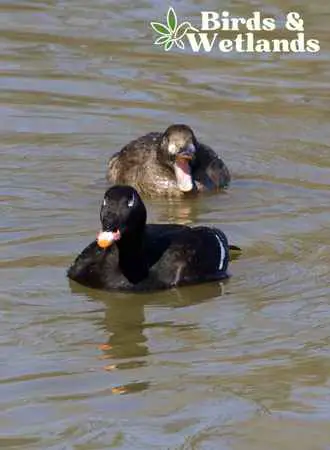
Threats & Conservation
The white-winged scoter is currently listed as “Least Concern” on the IUCN Red List due to its wide distribution, stable population, and presence in large numbers. However, they are still threatened by human activities such as climate change, urban development, oil spills and habitat loss.
Hunting
Hunting white-winged scoters in the United States is strictly regulated, with harvest quotas and limits set by the U.S. Fish and Wildlife Service. Hunters in permitted areas can take a specific number of birds based on the state’s daily bag and possession limits.
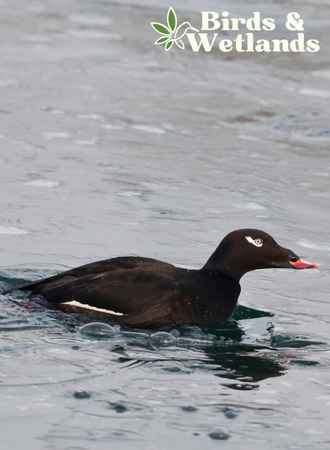
Key Points
- White-winged scoters are named after their white-wing patch.
- Adult males have a large black knob at the base of the bill.
- Flocks spend winters in coastal areas along the Atlantic and Pacific Coasts.
- Breeding areas are usually on the ground close to the water.

